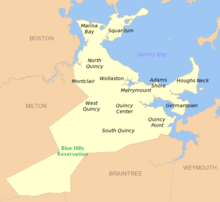Merrymount (Quincy, Massachusetts)
Merrymount is a primarily residential neighborhood of Quincy, Massachusetts, located between the neighborhoods of Quincy Center and Adams Shore.[1] Although it was the site of Quincy's initial settlement, Merrymount was not substantially developed for residential use until the first half of the 20th century, and most of the neighborhood's houses date from that period.[1][2]
History
Merrymount takes its name from the colony of Mare Mount, also known as Merry Mount or Merrymount. Colonist Thomas Morton wrote that the natives called the area "Pasonagessit" and that the inhabitants translated this to "ma-re mount".[3] The colony, established in 1625, was officially named Mount Wollaston by the Puritan separatists, but as Morton and other non-Puritans gained influence in the area, the name Merry Mount gained common use. In 1627, Morton and others erected a Maypole and conducted a May Day Revel, inviting both colonists and natives. This was the inspiration for the Nathaniel Hawthorne short story The Maypole of Merry Mount. The Puritan Separatists at Plymouth were scandalized and made concerted efforts to repress Morton and what they considered to be his pagan leanings. Finally, in 1630, with the arrival of Governor Winthrop and 900 more Puritans to what would become Boston, the combined Puritans were able to arrest and deport Morton, and the colony of Mount Wollaston/Merrymount was officially dissolved.
The land of the former colony was absorbed by Boston in 1634, then six years later made part of Braintree. The land was eventually sold to an ancestor of Abigail Adams, and came to be owned by the Adams family.[4] Prior to this point, the Merrymount area had been home to a substantial Native American population.[2] In 1792, Braintree was divided into several smaller towns, and much of what was once Mount Wollaston was incorporated as the new town of Quincy.
The area that is now Merrymount remained in the Adams' possession until the early 20th century, at which point it was sold off as housing lots. Development consisted mainly of single-family houses and was largely completed by the post-World War II era.[2] A contemporary account from that period describes Merrymount as "the nicest section of Quincy."[5]
Today
Merrymount, as it is currently recognized, is bordered to the north by Quincy Bay, to the west by Black's Creek, to the south by Quincy Center, and to the east by Adams Shore. Landmarks include the Mount Wollaston Cemetery and Merrymount Elementary School.
External links
Woodbury, C. L. Genealogical Sketches ... (1904) J. B. Clarke Company, "The Maypole in New England", (pg 50 via archive.org)
References
- 1 2 Gordon, Heather (2004). Newcomer's Handbook For Moving To And Living In Boston. First Books. p. 135. ISBN 0-912301-54-6. Retrieved 2008-10-23.
- 1 2 3 "Quincy neighborhoods". Retrieved 2009-07-14.
- ↑ Thomas Morton. "New English Canaan", Chapter XIV; published 1637
- ↑ Herring, James; Longacre, James Barton (1853). The National Portrait Gallery of Distinguished Americans. D. Rice & A.N. Hart. p. 1. Retrieved 2008-10-22.
- ↑ Frommer, Myrna Katz; Frommer, Harvey (1999). Growing Up Jewish In America. Sylvia Skoler Portnoy. University of Nebraska Press. p. 33. ISBN 0-8032-6900-5. Retrieved 2008-10-22.
| ||||||||||||||||||||||||||||||||||||
Coordinates: 42°15′45″N 70°59′43″W / 42.2626°N 70.9953°W
